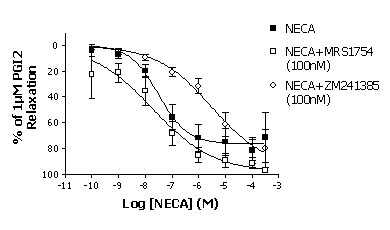| pA2
online © Copyright 2003 The British Pharmacological Society |
027P
University
of Manchester Autumn Meeting September 2003 |
| Adenosine A2A receptors are responsible for NECA-induced vasodilatation in human isolated middle cerebral arteries J.A. Root, R.A. Borman & K.L. Clark, Pharmagene Laboratories Ltd, 2 Orchard Road, Royston, Herts, UK. SG8 5HD. |
Print Abstract |
During periods of ischaemia, hypoxia, or enhanced oxygen demand, adenosine may mediate cerebral artery vasodilatation in humans. The adenosine receptor subtype responsible is believed to be of the A2 class (Hardebo et al., 1987), although it has not been determined whether high affinity A2A or low affinity A2B receptors are responsible. The aim of the present study was to determine which of these subtypes is responsible for the dilatation induced by the non-selective A1/A2 agonist 5'-(N-ethylcarboxamido)-adenosine (NECA).
Human cerebral arteries were obtained from 5 donors (2 female, 3 male, aged between 33 and 79) at post mortem (PM) with the informed consent of next of kin, and with the approval of local ethics committees. Tissue was placed in PBS at 4°C and transported overnight for use the following day, the mean (± s.e.m.) PM delay was 5.8 ±0.6 hours. Rings of middle cerebral artery were mounted in 10ml organ baths containing gassed Krebs solution (95% O2 / 5% CO2) at 37°C under isometric conditions and an initial tension of 5mN. The integrity of the endothelium in each case was not established. After 60 minutes equilibration, a cumulative concentration-effect curve to the thromboxane A2 mimetic, U46619, was constructed. After washing, the selective A2A antagonist ZM241385 (Ongini et al., 1999) or the selective A2B antagonist MRS1754 (Ji et al., 2001) was added at 100nM and left in contact with the tissues for 30 minutes. Vessels were constricted with an approximate EC50 concentration of U46619 (10-100nM) and allowed to plateau, after which NECA (100pM - 300µM) was added by cumulative application. After addition of the final concentration of NECA, prostacyclin (1µM) was administered to induce a standard relaxation. The equation (log10 (concentration ratio - 1)) - (log10 [antagonist]) was used to estimate pA2 values.Cumulative administration of NECA to pre-constricted arteries in the absence of antagonist resulted in a concentration-dependant vasodilatation (pEC50 7.5 ± 0.1). The A2B receptor antagonistMRS1754 produced no significant shift in the NECA concentration-response curve (pEC50 7.7 ± 0.3), whereas the A2A antagonist ZM241385 produced a significant rightward shift (pEC50 5.5 ± 0.3, pA2 8.7 ± 0.2, Figure 1). The estimated pA2 value for ZM241385 compares well with its published affinity (pKi=9.1) for human recombinant A2A receptors (Ongini et al., 1999).

Figure 1. Concentration-response curves to NECA in U46619 pre-contracted human middle cerebral arteries in the absence and presence of A2R antagonists. Data are expressed as a percentage of the relaxation caused by 1µM prostacyclin, mean ± s.e.m. (n=4-5).
In conclusion, NECA-induced vasodilatation of human middle cerebral arteries appears to be mediated via adenosine A2A receptors.
Hardebo,
J.E., Kahrstrom, J., Owman, C. (1987) Eur. J. Pharmacol., 144,343-52.
Ji, X., Kim, Y.C., Ahern, D.G., et al (2001) Biochem. Pharmacol.,
61, 657-63.
Ongini, E., Dionisotti, S., Gessi, S., et al (1999) Naunyn-Schmiedeberg's
Archives of Pharmacology. 359, 7-10.